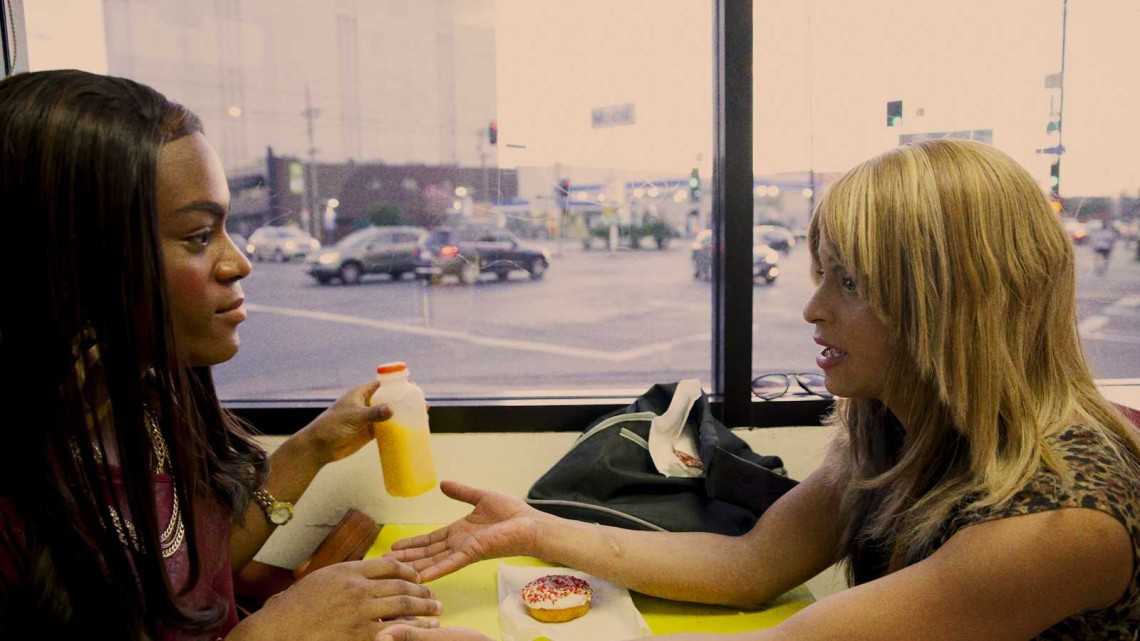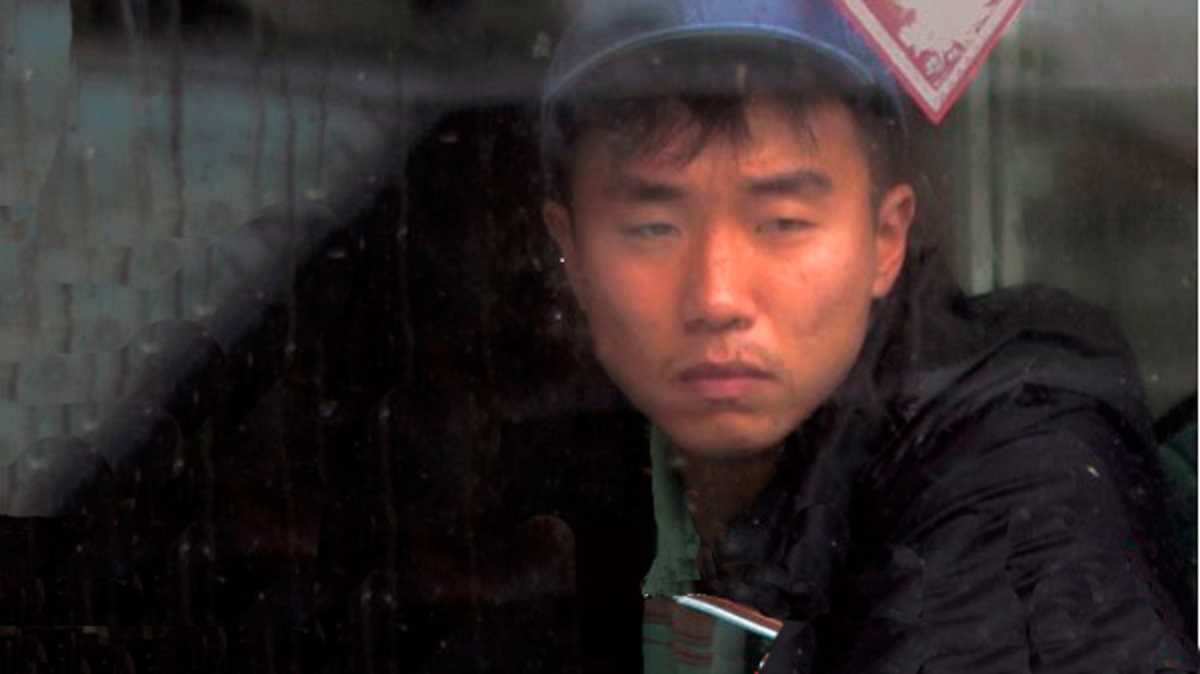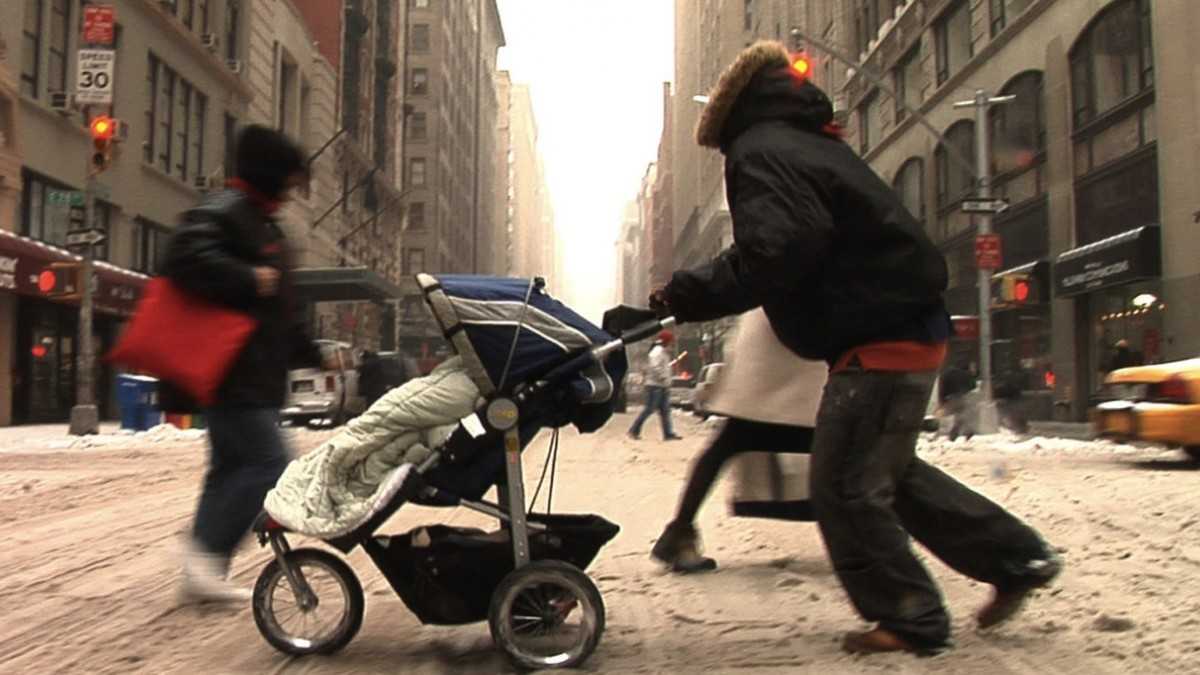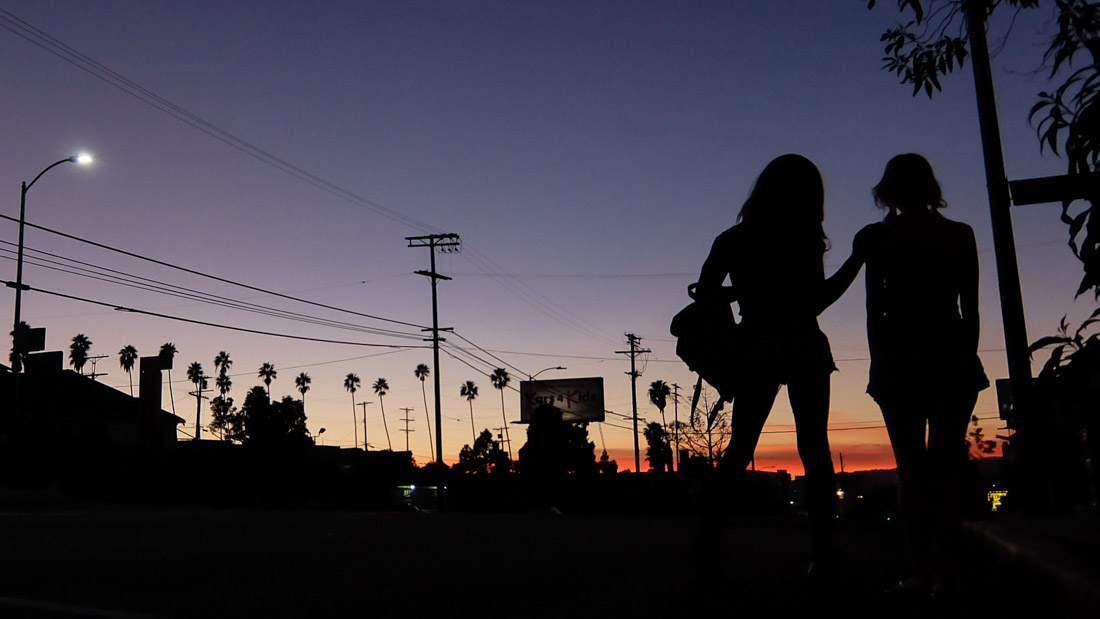Regardless of his eventual standing next year, one man has handily filled 2015’s entertainment quota: Donald Trump. In announcing his candidacy for President of the United States (again), he gave the following thoughts on illegal immigration: “When Mexico sends its people, they’re not sending their best….They’re sending people who have lots of problems….They’re bringing drugs. They’re bringing crime, their rapists.” Trump speaks in a unique language of Grandiosity and Us vs. Them and red-faced aggression that gives speeches like this millions of Facebook shares in the far-right corners of the internet and emotional lability to anyone else. With Trump’s towering rhetoric and the unbelievable number of tragedies and murders in the U.S. this year, it’s becoming increasingly difficult to find equal cultural output that thinks through why humans treat each other poorly.
Sean Baker is certainly not as loud as Donald Trump. His most popular film so far, Starlet, made less than $100,000 in ticket sales (roughly nine thousand tickets sold), while Trump receives wide cable-news coverage for his every political remark. This is to be expected: Anybody that says “think about this” rather than “act now” will invariably be taken out of the spotlight, unfortunately. And Baker is always saying the former. His principal characters are routinely outside the establishment in the most radical way, often a part of the “not sending their best” portion of Trump’s choosing. That’s the kicker: Baker’s characters aren’t imagined saints of the poor that any noblesse oblige filmmaker would elevate to get a liberal point across. They work in vice (sex workers, porn actors, illegal-goods salesmen) and usually have only themselves in mind—at least until a big moral predicament. Add to this some rough DV, handheld HD, and iPhone 5S photography, and the vérité simply sweats off the screen.
For the sake of a manageable scope in this survey of Baker’s career to date, I won’t be covering his television series (IFC’s Greg the Bunny and MTV’s Warren the Ape) and his first film venture Four Letter Words—the former due to their outlier status among Baker’s work, the latter due to relative unavailability. Instead, let’s start in Manhattan, 2004, with the looming shadows of the Twin Towers still fresh in every frame.
Baker’s first video effort, co-directed with Shih-Ching Tsou, is admittedly sophomoric. Made in the no-budget ($3000) vérité style, Take Out (2004) follows an illegal Chinese immigrant, Ming Ding (Charles Jang), as he struggles to pay back his debtors by the end of the day. However, most of the film’s running time is dedicated to shots of the nondescript take-out kitchen and Ming’s delivery route. This is no experimental narrative trick or leftover b-footage salvage: By placing the audience’s time and dedication with Ming’s perseverance (he takes every delivery for that day to pay the $800 he owes), Baker and Tsou seek to create empathy with Ming. It’s a familiar kind of humanizing that resemble Robert Bresson’s doomed figures and the Dardennes’ Sisyphus characters complete with close-ups of well-worn faces and several verbal barrages against the protagonist. But Ming is no Joan of Arc: His humanity is accepted prima facie in the opening scenes and supported only through his work ethic and ability to put up with Manhattanite stereotypes; beyond his predicament, he never seems to exude an inner life outside the boundaries of the screenplay. Combine that with a rough-and-tumble photographic look (more family video log than John Cassavetes or Jean Rouch) with faces occasionally blocking the principal speaking actor or a destabilized camera zooming into anything of visual interest, and Take Out comes across as little more than a rough sketch for Baker’s later work.
All is not lost. The best thing to come from Take Out is its vision of Manhattan—specifically, that surreal, how-could-anyone-possibly-live-here Manhattan that comes only from a rough DV image that mutes any inkling of color. One scene after a late-night delivery opens with Ming saddling onto his bike in a downpour, his raincoat only just blocking sharp droplets from his face. He’s as blank as a Bresson model, focused on the job and nothing else. City lights reflect off the puddles in a morphed, dull form of their former glory. He pedals ahead to the next job. If Ming is working this hard in order to stay in this version of the city, his life surely must have been hellish before.
Baker goes from no-wave to new-wave in his next film, Prince of Broadway (2008), in which a surveillance aesthetic takes a back seat to careful framing. The film bounces around scenes with peppered jump cuts and improvised exclamations, never quite slowing down even in its most intimate moments. Lucky (Prince Adu), again an illegal immigrant (this time from Ghana), must make his way through life in Manhattan’s wholesale district as a former lover dumps an infant in his care. There’s lots of yelling, particularly at the kid whose only job is to sit there and look harmless. Lucky’s narrative goal is to eventually find the audience’s empathy by having no preparation in taking care of a small child, but he doesn’t exactly win this by being a saint. Instead, he acts how anybody forced into responsibility might: in absolute terror.
Whether or not it’s actually Lucky’s child doesn’t really matter (though we still get to find out thanks to that nagging feeling reaching a tipping point by the end). What separates Prince of Broadway from the clunky humanism of Take Out lies in Lucky’s winning his humanity. He’s a criminal and more concerned with his freedom than the child’s future, but lone moments of caustic remarks (“Life sucks with you!” repeated ad nauseum) matched with deeper moments of bonding help transcend its hackneyed set-up.
And again, its portrait of New York in the background is deeply impressive. Baker admits to investigating and researching the wholesale district for a year; Prince Adu even had a hand in showing Baker’s crew the Ghanaian émigré haunts and how the off-putting decay above them dominates their daily lives. Baker’s move from cheap DV to handheld HD removes that horror-movie black palette from the background. Instead, large swaths of snowstorm white and neon red place this little-filmed district into the visual language of the apocalypse. Anybody who’d say that Lucky is “making a living” would be hard-pressed to call this environment livable. And yet, Lucky lives. Baker describes the district as “the most chaotic, colorful, and energetic parts of the city,” which is the polite way of saying that it isn’t gentrified and NYC at large doesn’t really care about it in any financial terms. The district’s best quality is its people…and outside the little-seen Prince of Broadway, NYC doesn’t seem to care about them, either.
Then comes a big switch in his next film, Starlet (2012). The best way to talk about this film comes from this interview with Baker posted on the Film Society of Lincoln Center website:
“It’s kind of creepy and disturbing, but the girls’ rooms were often decorated like little girls’ bedrooms. There is obviously a psychological motivation behind keeping these girls in a pre-adolescent environment. It was really strange, but I saw it in every place I went to. There were bright colors—pinks and yellows—and teddy bears everywhere. I didn’t see a lot of women in their early 20s who, let’s just say, had their lives together.”
Baker, hyper-aware of how much location can communicate in a film, scatters Starlet with focused impressions like this. The set-up: Nubile Los Angeles porn actor Jane (Dree Hemingway, of the Ernest/Mariel Hemingway lineage) finds way too much money in little old Sadie’s (Besedka Johnson) thermos at a yard sale. Sadie has no recollection of the money, so Jane repays her via little favors, ultimately becoming a nuisance with her underlying motivation (guilt or real empathy/friendship) in question. The execution: Johnson can kill by not saying a word during a tense scene. Baker peppers both porn-shoot houses with those strange jejune details. The stone-faced Bressonian acting style Baker likes is upended with some really funny moments. A scene in which hyper-masculine porn star Mikey takes a nap next to his ridiculous stripper pole and cheap light show while Buckcherry’s godawful “Crazy Bitch” plays to no one is made even funnier by the choice of Baker’s DP, Radium Cheung, to capture the absurd scene in one shot. Baker’s general abandonment of surveillance-inspired camera work allows Cheung to not only capture witty moments like that, but also allow him to properly block every scene from still conversation to the more kinetic breakdowns.
If Baker’s strongest visual tool in his previous films was New York, however, why would he move to Los Angeles? As it turns out, he seems to present every location with ease, even without the vertical structures of Manhattan. The California sun allows for more colors, allowing that pop of bright adolescence to effectively mask the ill-intentioned businesspeople inside. Again, handheld HD is necessary: Low-cost DV wouldn’t pick up the variety of flowers in Sadie’s garden, nor could it pick up just how dull the key lighting is in those porn shoots.
Final question: If Jane isn’t as disenfranchised as Ming and Lucky (at least in terms of money/responsibility), will Baker be able to grant her the same level of empathy? Not quite. Since neither Jane’s financial nor family situation is ever specified, her only visual suffering (before a dramatic turning point) comes not from poverty or unexpected parenthood, but from mere boredom. A number of scenes depict Jane staring at the television while Mikey plays various first-person-shooter games. Then come a series of boring realizations. There’s the realization that most of the porn business lies in marketing, accounting, and general cubicle work: When Jane’s friend Melissa (Stella Maeve) storms into her porn agency’s offices, Sadie wonders aloud if it’s some sort of insurance building. There’s also the realization that making pornography, like making any film, mostly consists of waiting and that waiting gets really boring. Even the actual porn scenes are boring, resembling more rote physical activity than anything with passion. In other words, all of the dramatic tension rests in Jane and Sadie’s relationship, which often resembles Lucky and his kid—caretaker and confused ward.
Now, the catalyst for this profile: Tangerine (2015). The most important thing to talk about here has in fact already been perfectly articulated by Andreas Stoehr over at The (sadly late) Dissolve (n.b.: “Neither character is required to prove her womanhood or her humanity. Nor must they bare themselves to audience scrutiny. Instead, the film accepts their identities at face value, then rolls along with plenty of economy and momentum.”). Where Baker could easily risk fetishizing their struggle as transgender vs. the world per Dallas Buyers Club, empathy is instead distributed via his particular brand of world-building around Sin-Dee (Kitana Kiki Rodriguez) and Alexandra (Mya Taylor). This means very little mention of their past (what little remains is still devastating, like Alexandra’s “What family?”), a refusal to paint their work as something evil, and (since it’s a comedy) absolutely no jokes at their identity’s expense.
In case that comes across as implying it’s full of politically correct niceties, consider this: Tangerine begins with Sin-Dee getting out of jail and immediately seeking revenge on her cheating boyfriend and his new fish (cisgender) girlfriend. There are plenty of jokes made at the expense of Sin-Dee’s personality (“She’s out of jail for 24 hours and she’s already causing drama!”)—jokes often needed to bring levity to her vicious behavior. Despite her violence, Sin-Dee is fun to listen to. She speaks in a rhythmic machine-gun pace, a million thoughts spilling with every step, as if blending in with the symphony of car alarms and occasional trap or club beat in the soundtrack. In short, she’s a bit of an anti-hero: wrongheaded in every scene, yet still lovable.
On the visual front, just look at that extraordinarily vivid orange tint that dominates every daytime exterior shot. It took recurring verbal reminders that it was Christmas Eve to really drive home the fact it’s December and there’s a whole ironic spirit-of-the-season element at play here. It’s unreal, Instagram-quality color grading—which is particularly confusing when remembering (and it’s a measure of how impressive it looks that you really do have to remind yourself) that it was shot entirely on an iPhone 5S, the go-to camera for guerrilla-style realism. This lends a hyper-artificiality to Baker’s L.A. that makes its personalities shine brighter, its vomit sequences even nastier, and the eventual nighttime even darker. Baker is quite opinionated about Los Angeles and quite proud that it may pass the Thom Andersen geography test. It makes sense that that passion would filter into Tangerine’s look, whether it be through the shot/reverse-shot humor (Rodriguez can pull off a great wide-eyed shocked face), the electric strutting scenes, the unbearable moments of being stuck in traffic with some chattering asshole, or the camera’s hovering on the sunset for a rare quiet moment.
Tangerine’s light-hearted air collapses in Baker’s signature twist at the end, a genuine shocker compared to his previous attempts. No spoilers here, except to say that, far from being a cheap gimmick, the twist is warranted, confirming the undercurrent of contempt the environment has for these characters, and allowing a separate, pungent reality leak into the film. That this action leads to the most beautiful scene in Baker’s career is the biggest middle finger to anyone with political incentives against these characters.
Are there any through-lines in Baker’s short career so far? Quite a few: the Dardenne-like narrative framing; the concluding twists that come at the end of all of his features that grant the entire film another empathetic lens; the commitment to André Bazinian realism—a gritty, guerrilla camera finding its way to these very flawed characters.
Above all else, though, Baker is consistently political. Ideally, he ought not to be seen that way: His portraits of disenfranchised people finding their way through moral gray areas should be taken face-value as a call for apolitical humanism. But, in The Year of the Trump, [Tangerine spoiler alert] calling the piss-thrower in Tangerine a very bad person is a political statement. That a criminal like Lucky should ask for our empathy even though he goes back to selling illegal wares is a political statement. There’s no Marxist underpinning here, no feminist call-to-arms, and even very few LGBT-ally proddings in Tangerine. Baker’s strongest work has come at a time when it will be most misunderstood. It has also come at a time when it is most needed.





















